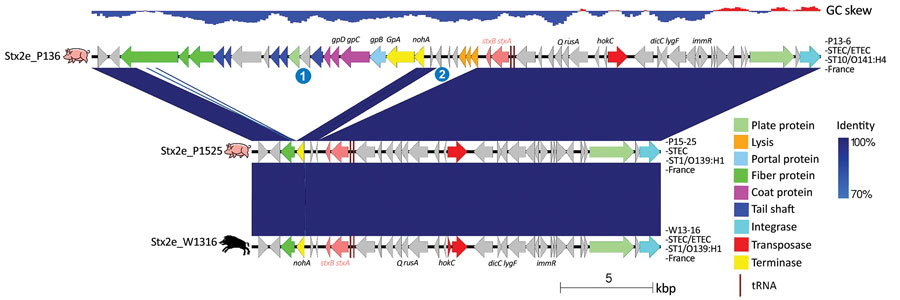Wild Boars as Reservoir of Highly Virulent Clone of Hybrid Shiga Toxigenic and Enterotoxigenic Escherichia coli Responsible for Edema Disease, France
Alexandre Perrat, Priscilla Branchu, Anouk Decors, Silvia Turci, Marie-Hélène Bayon-Auboyer, Geoffrey Petit, Vladimir Grosbois, Hubert Brugère, Frédéric Auvray

, and Eric Oswald

Author affiliations: Institut de Recherche en Santé Digestive, Université de Toulouse, Institut National de la Santé et de la Recherche Médicale, Institut National de Recherche pour l’Agriculture, l’Alimentation et l’Environnement (INRAE), Ecole Nationale Vétérinaire de Toulouse, Université Paul Sabatier, Toulouse, France (A. Perrat, P. Branchu, H. Brugère, F. Auvray, E. Oswald); Office Français de la Biodiversité, Orléans, France (A. Decors); Labocea, Ploufragan, France (S. Turci, M.-H. Bayon-Auboyer); Université Clermont Auvergne INRAE, VetAgro Sup, Unité Mixte de Recherche (UMR) Epidémiologie des Maladies Animales et Zoonotiques, Saint-Genès-Champanelle, France (G. Petit); UMR Animal-Santé-Territoires-Risques-Ecosystèmes, Centre de Coopération Internationale en Recherche Agronomique pour le Développement, INRAE, Montpellier, France (G. Petit, V. Grosbois); Centre Hospitalier Universitaire de Toulouse, Hôpital Purpan, Toulouse (E. Oswald)
Main Article
Figure 3

Figure 3. Comparison of the Stx2e prophages of wild boar Escherichia coli O139:H1 strain W13-16 and pig E. coli O139:H1 P15-25 and O141:H4 P13-6 strains from France. The genes are represented with arrows color coded by function. The 2 regions present in prophage Stx2e_P136 but absent in the 2 other prophages are indicated by numbers 1 and 2. The areas between the genetic maps are shaded in blue, with a color intensity depending on the percentage of identity between each region compared. Strain name, pathotype, sequence type, serotype, and country of isolation are indicated at the right of each map. The GC skew (negative, blue; positive, red) is indicated at the top. ETEC, enterotoxigenic Escherichia coli; ST, sequence type; STEC, Shiga toxin–producing Escherichia coli.
Main Article
Page created: December 01, 2021
Page updated: January 27, 2022
Page reviewed: January 27, 2022
The conclusions, findings, and opinions expressed by authors contributing to this journal do not necessarily reflect the official position of the U.S. Department of Health and Human Services, the Public Health Service, the Centers for Disease Control and Prevention, or the authors' affiliated institutions. Use of trade names is for identification only and does not imply endorsement by any of the groups named above.
